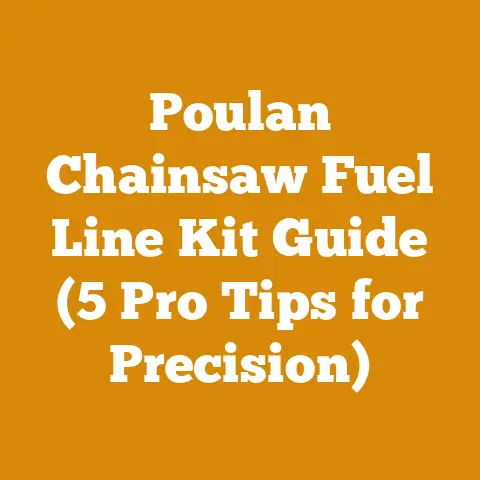Husqvarna 359 Rebuild Kit Guide (5 Pro Tips for Big Bore Mods)
Why Rebuild and Modify?
Before we dive into the nitty-gritty, let’s understand the “why.”
- Restoring Performance: Over time, a chainsaw’s engine loses compression. This can be due to worn piston rings, cylinder scoring, or leaky seals. A rebuild replaces these worn parts, restoring the engine to its original power output.
- Extending Lifespan: Regular maintenance and timely rebuilds can significantly extend the life of your chainsaw, saving you money in the long run compared to buying a new one.
- Increased Power (Big Bore): A big bore kit replaces the stock cylinder and piston with larger ones. This increases the engine’s displacement, resulting in more power and torque. This is especially useful for tackling larger diameter trees or harder wood types.
- Cost-Effectiveness: Rebuilding and modifying can be a more affordable option than purchasing a brand new, comparable chainsaw.
- The Satisfaction Factor: There’s a unique satisfaction that comes from understanding and working on your own equipment. You gain a deeper appreciation for how it works and the ability to maintain it properly.
Understanding Key Terms
Let’s define some terms that will be used throughout this guide:
- Compression: The pressure created in the cylinder when the piston moves upward, compressing the air-fuel mixture. Higher compression generally means more power.
- Cylinder: The part of the engine where the piston moves up and down. It’s where combustion takes place.
- Piston: A cylindrical component that moves within the cylinder, driven by the force of combustion.
- Piston Rings: Metal rings that fit into grooves on the piston, creating a seal between the piston and the cylinder wall. This prevents combustion gases from escaping and maintains compression.
- Big Bore Kit: A replacement cylinder and piston with a larger bore (diameter) than the stock parts, increasing engine displacement.
- Gasket: A sealing material placed between two surfaces to prevent leaks.
- Seal: A device used to prevent the leakage of fluids (fuel, oil) or gases.
- Carburetor: A device that mixes air and fuel in the correct proportion for combustion.
- Timing: The precise moment when the spark plug ignites the air-fuel mixture in the cylinder.
- Green Wood: Freshly cut wood with a high moisture content.
- Seasoned Wood: Wood that has been dried, reducing its moisture content. Seasoned wood burns more efficiently and produces less smoke.
Safety First!
Before you even think about touching your chainsaw, safety is paramount.
- Husqvarna 359 Rebuild Kit: This typically includes a new piston, cylinder, piston rings, wrist pin, circlips, gaskets, and seals. Choose a reputable brand like Meteor or Hyway.
- Big Bore Kit (Optional): If you’re going for the big bore modification, you’ll need a kit designed for the Husqvarna 359. These kits usually increase the bore size from the stock 46mm to 48mm or even larger.
- Piston Ring Compressor: This tool compresses the piston rings so you can install the piston into the cylinder.
- Circlip Pliers: For installing and removing the circlips that hold the wrist pin in place.
- Torque Wrench: Essential for tightening bolts and screws to the correct specifications.
- Socket Set: Metric sockets are needed for various bolts and screws.
- Wrench Set: Metric wrenches are also necessary.
- Screwdrivers: Both flathead and Phillips head screwdrivers.
- Pliers: For various tasks.
- Pick Set: Useful for removing seals and gaskets.
- Spark Plug Wrench: To remove and install the spark plug.
- Carburetor Adjustment Tool: To fine-tune the carburetor after the rebuild.
- Compression Tester: To check the engine’s compression before and after the rebuild.
- Feeler Gauges: For checking piston ring end gap (important for big bore kits).
- Two-Stroke Oil: For lubricating the engine during assembly and for mixing with fuel.
- Grease: For lubricating bearings and other moving parts.
- Parts Cleaner: To clean engine components.
- Shop Rags: For cleaning up spills and wiping down parts.
- Camera or Smartphone: To take pictures of the disassembly process. This will help you remember how everything goes back together.
- Marking Pen: To label parts as you disassemble them.
- Service Manual: A Husqvarna 359 service manual is invaluable.
Step-by-Step Guide to Rebuilding and Big Bore Modifying Your Husqvarna 359
This is where we get our hands dirty. I’ll guide you through each step, providing clear instructions and helpful tips based on my own experiences.
Step 1: Disassembly
- Remove the Air Filter and Top Cover: Start by removing the air filter cover and then the air filter itself. Then, remove the top engine cover.
- Remove the Muffler: The muffler is usually held in place by two or three bolts. Remove these bolts and carefully remove the muffler.
- Remove the Carburetor and Intake Manifold: Disconnect the fuel lines from the carburetor. Be careful, as there may be some fuel remaining in the lines. Remove the bolts holding the carburetor and intake manifold to the cylinder.
- Remove the Cylinder Head Cover (if applicable): Some Husqvarna 359 models have a separate cylinder head cover. If yours does, remove it.
- Remove the Cylinder: This is where things get interesting. Remove the bolts holding the cylinder to the engine case. Once the bolts are removed, carefully wiggle the cylinder off the piston. It may be a bit tight. Pay attention to the orientation of the cylinder as you remove it.
- Remove the Piston:
- Remove the Circlips: Use circlip pliers to carefully remove the circlips that hold the wrist pin in place. Be extremely careful not to drop the circlips into the engine case. I’ve learned this the hard way – fishing them out is a pain!
- Remove the Wrist Pin: Once the circlips are removed, you can push the wrist pin out. You may need to use a punch and a hammer to gently tap it out.
- Remove the Piston: With the wrist pin removed, the piston can be removed from the connecting rod.
- Inspect All Parts: Carefully inspect all the parts you’ve removed for wear or damage. Pay close attention to the cylinder walls, piston, piston rings, wrist pin, and bearings. Look for scoring, cracks, or excessive wear. If you’re doing a big bore modification, you’ll be replacing the cylinder and piston regardless, but it’s still a good idea to inspect the old parts to understand how they wore.
Step 2: Preparing for Reassembly
- Clean All Parts: Thoroughly clean all the parts you’ll be reusing with parts cleaner. Remove any dirt, grime, or old gasket material. A clean engine is a happy engine.
- Inspect the Engine Case: Inspect the engine case for any damage or cracks. Make sure the bearings are in good condition.
- Check Piston Ring End Gap (Big Bore Kits): This is a critical step when installing a big bore kit. The piston rings need a small gap to allow for expansion when the engine heats up.
- Insert the Piston Rings into the Cylinder: Place each piston ring into the cylinder bore, one at a time.
- Use the Piston to Square the Ring: Use the piston to push the ring down into the cylinder, ensuring it’s square.
- Measure the End Gap: Use feeler gauges to measure the gap between the ends of the piston ring.
- Adjust the End Gap (If Necessary): If the end gap is too small, you’ll need to file the ends of the piston ring until it’s within the manufacturer’s specifications. I use a fine file and take my time, checking the gap frequently. Too large a gap will reduce compression, while too small a gap can cause the ring to bind and damage the cylinder. For a 48mm big bore kit, I typically aim for an end gap of around 0.012″ – 0.016″.
- Lubricate Everything: Lubricate all the parts with two-stroke oil before reassembly. This will help prevent wear during initial startup.
Step 3: Reassembly
- Install the Piston:
- Attach the Connecting Rod: Connect the piston to the connecting rod using the wrist pin. Make sure the arrow on the piston points towards the exhaust port.
- Install the Circlips: Install the circlips to secure the wrist pin. Make sure the circlips are properly seated in their grooves. This is another area where I’ve learned from experience – a poorly installed circlip can come loose and cause catastrophic engine damage.
- Install the Piston Rings: Carefully install the piston rings onto the piston. Make sure the ring ends are properly positioned in their respective grooves.
- Install the Cylinder:
- Lubricate the Cylinder Bore: Lubricate the cylinder bore with two-stroke oil.
- Use a Piston Ring Compressor: Use a piston ring compressor to compress the piston rings.
- Carefully Slide the Cylinder Over the Piston: Gently slide the cylinder over the piston, making sure the piston rings don’t catch on the cylinder walls. This can be a bit tricky, so take your time and be patient.
- Secure the Cylinder: Bolt the cylinder to the engine case. Torque the bolts to the manufacturer’s specifications.
- Install the Carburetor and Intake Manifold: Install the intake manifold and carburetor. Connect the fuel lines.
- Install the Muffler: Install the muffler.
- Install the Cylinder Head Cover (if applicable): If your model has a cylinder head cover, install it.
- Install the Air Filter and Top Cover: Install the air filter and top engine cover.
- Install the Spark Plug: Install the spark plug.
Step 4: Tuning and Break-In
- Start the Engine: Connect the spark plug wire and start the engine. It may take a few pulls to get it started.
- Adjust the Carburetor: Adjust the carburetor to ensure the engine is running smoothly. The Husqvarna 359 has three adjustment screws: L (low speed), H (high speed), and LA (idle speed). I recommend starting with the factory settings and then fine-tuning from there. Use a tachometer to ensure the engine is not over-revving. A safe maximum RPM for a modified Husqvarna 359 is around 13,500 RPM.
- Break-In Period: It’s important to break in the new engine properly. Run the engine at varying speeds for the first few hours. Avoid prolonged periods of full throttle. I typically run a few tanks of fuel with a slightly richer oil mixture (e.g., 40:1 instead of 50:1) during the break-in period.
- Check Compression: After the break-in period, check the engine’s compression with a compression tester. A healthy engine should have a compression reading of at least 150 PSI.
5 Pro Tips for Big Bore Mods
Now, let’s dive into some pro tips that can help you get the most out of your big bore modification.
- Squish Band Adjustment: The squish band is the area between the piston and the cylinder head when the piston is at top dead center (TDC). Optimizing the squish band can significantly improve engine performance. A tighter squish band (around 0.020″ – 0.025″) can increase compression and improve combustion efficiency. This often requires removing material from the cylinder base or using a thinner base gasket. This is an advanced modification and requires careful measurement and precision. I use a piece of solder placed on the piston crown to measure the squish.
- Porting: Porting involves modifying the intake and exhaust ports of the cylinder to improve airflow. This can increase horsepower and torque, but it’s a delicate process that requires specialized tools and knowledge. I recommend starting with mild porting modifications and gradually increasing the aggressiveness as you gain experience.
- High-Performance Carburetor: The stock carburetor may not be able to provide enough fuel for a big bore engine. Upgrading to a high-performance carburetor can improve fuel delivery and allow the engine to reach its full potential. Walbro and Tillotson are popular brands for chainsaw carburetors.
- Timing Advance: Advancing the ignition timing can improve throttle response and increase power. This can be achieved by modifying the flywheel or using an adjustable ignition module. However, advancing the timing too much can lead to detonation and engine damage.
- Exhaust Modification: Modifying the exhaust system can reduce backpressure and improve exhaust flow. This can increase horsepower and torque. A simple modification is to remove the spark arrestor screen from the muffler. More advanced modifications involve porting the muffler or replacing it with a high-performance aftermarket muffler.
Case Study: My Husqvarna 359 Big Bore Project
I recently rebuilt and modified my own Husqvarna 359 with a 48mm big bore kit. I also performed some mild porting and adjusted the squish band to 0.022″. After tuning the carburetor, the saw ran like a beast. I used it to fell a large oak tree that I had been putting off for months. The saw ripped through the oak with ease, and I was amazed at the increase in power.
Here’s a breakdown of the costs involved:
- Big Bore Kit (Hyway): \$150
- Gaskets and Seals: \$20
- Carburetor Adjustment Tool: \$15
- Two-Stroke Oil: \$20
- Total: \$205
The entire project took me about 8 hours to complete. The biggest challenge was adjusting the squish band. It required several iterations of measuring and grinding to get it just right. But the results were well worth the effort.
Wood Type Selection and Firewood Preparation
Now that your Husqvarna 359 is rebuilt and modified, let’s talk about wood type selection and firewood preparation. The type of wood you’re cutting and the way you prepare it can significantly impact your efficiency and the quality of your firewood.
- Hardwoods vs. Softwoods: Hardwoods (like oak, maple, and ash) are denser and burn longer than softwoods (like pine, fir, and spruce). Hardwoods are generally preferred for firewood.
- Green Wood vs. Seasoned Wood: Green wood has a high moisture content and is difficult to burn. Seasoned wood has been dried and burns more efficiently.
- Felling Techniques: When felling trees, it’s important to use proper techniques to ensure your safety and to avoid damaging the tree. The three-cut method (notch cut, back cut, and felling cut) is a common and effective technique.
- Debarking Logs: Debarking logs can speed up the drying process and reduce the risk of insect infestation.
- Splitting Firewood: Splitting firewood can be done manually with an axe or with a hydraulic log splitter. Hydraulic log splitters are much faster and easier, especially for larger diameter logs. I personally use a 25-ton hydraulic log splitter.
- Stacking Firewood: Stacking firewood properly allows for good air circulation, which is essential for drying. I typically stack my firewood in rows, with gaps between the rows to allow for airflow.
- Drying Times: The drying time for firewood depends on the type of wood and the climate. Hardwoods typically take 6-12 months to dry, while softwoods can dry in 3-6 months. The target moisture content for seasoned firewood is below 20%.
Strategic Advantages of Using a Modified Chainsaw
Using a rebuilt and modified chainsaw offers several strategic advantages:
- Increased Productivity: The increased power and torque allow you to cut through wood faster and more efficiently.
- Reduced Fatigue: The increased power reduces the amount of effort required to cut through wood, reducing fatigue.
- Improved Safety: A well-maintained and properly tuned chainsaw is safer to use than a neglected one.
- Cost Savings: Rebuilding and modifying your chainsaw can be more cost-effective than buying a new one.
- Greater Control: You have more control over the performance of your chainsaw, allowing you to tailor it to your specific needs.
Challenges and Considerations
While rebuilding and modifying a chainsaw can be a rewarding experience, there are also some challenges and considerations to keep in mind:
- Complexity: The process can be complex and requires a good understanding of engine mechanics.
- Time Commitment: Rebuilding and modifying a chainsaw can take several hours.
- Cost: While it can be more cost-effective than buying a new chainsaw, there are still costs involved, such as the cost of the rebuild kit and other tools and materials.
- Warranty: Modifying your chainsaw may void the warranty.
- Safety: It’s important to take safety precautions to avoid injury.
- Potential for Damage: If not done properly, rebuilding and modifying your chainsaw can damage the engine.
Next Steps
Ready to unleash the beast within your Husqvarna 359? Here are some practical next steps:
- Gather Your Tools and Materials: Make sure you have all the necessary tools and materials before you start.
- Study the Service Manual: Familiarize yourself with the Husqvarna 359 service manual.
- Watch Videos and Read Articles: There are many videos and articles online that can provide additional guidance.
- Start Small: If you’re new to chainsaw repair, start with a simple rebuild before attempting a big bore modification.
- Take Your Time: Don’t rush the process. Take your time and pay attention to detail.
- Ask for Help: If you get stuck, don’t be afraid to ask for help from a qualified mechanic or experienced chainsaw user.
Final Thoughts
Rebuilding and big bore modifying a Husqvarna 359 is a challenging but rewarding project. It’s a chance to learn more about engine mechanics, improve your chainsaw’s performance, and save money in the long run. By following this guide and taking the necessary precautions, you can transform your Husqvarna 359 into a true cutting machine. Remember to always prioritize safety and to have fun! The roar of a finely tuned, modified chainsaw ripping through a log is a sound that never gets old. Now, go forth and conquer those trees!






